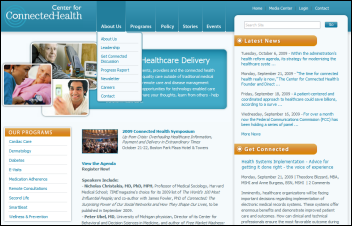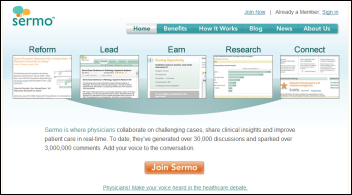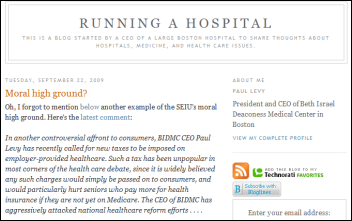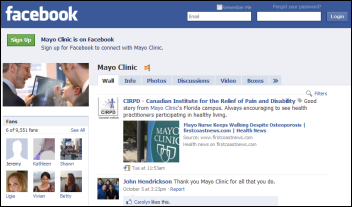 For marketers in any industry—from manufacturing to real estate to banking, and everything in between—making the business case for social media isn’t a quick and easy process.
For marketers in any industry—from manufacturing to real estate to banking, and everything in between—making the business case for social media isn’t a quick and easy process.
But in healthcare marketing, it’s an understatement to say that gaining buy-in for social media isn’t easy.
Consider for a moment just what healthcare marketers are up against:
- A multitude of privacy regulations
- Nursing and support staff shortages
- Increasing demand for services thanks to the quickly aging Baby Boomer generation
It’s not difficult to understand why some healthcare decision makers may be slow to adopt social media. But instead of throwing in the towel, consider these 5 tips for making the case for social media in healthcare marketing:

1. The movement has started. Healthcare may not be as quick to adopt social media as some other industries. But there are many hospitals and healthcare organizations that are quietly innovating on the social web, as Digital Influence blogger Rohit Bhargava suggests.
In a recent post, he points out that there are 367 US hospitals using social media. They are responsible for 10,000 Tweets from 267 Twitter accounts. When making your individual case for social media in healthcare marketing, leverage some of the great examples out there:
- Patients Like Me is an online community site created in 2004 by MIT engineers to allow patients to share information and their personal experiences. The goal is to connect patients with the same or similar diseases so they can rely on one another for support.
- The Center for Connected Health community website is designed for healthcare providers and policymakers. Community members can discuss controversial topics, and share best practices, new ideas, upcoming events and research.
- Individual hospitals are involved in social media efforts as well, Bhargava points out. The Sarasota Memorial Hospital uses Twitter to answer patient questions and provide immediate customers service. In March, the Henry Ford Hospital used Twitter to connect with 1,900 people and answer questions during an actual brain surgery.

2. Patients—and potential future patients—are involved in social networks. A March 2009 report (pdf) from Nielson Online found that 67% of the global online population takes part in online communities. Plus, time spent on social media sites now accounts for almost 10% of all time online.
Clear and simple, patients use social media. Hospitals can utilize social channels to answer healthcare- or illness-related questions or simply provide medical information—just as the Sarasota Memorial and Henry Ford hospitals have done. If the numbers aren’t convincing enough, consider this: Patients are comparison shopping for hospitals, CNN reports.
With the increasing cost of healthcare and a growing number of available hospitals, it’s only natural. Social media is just one tool for hospitals and healthcare organizations to stay top of mind and relevant for patients.

3. Patients are online, and so are physicians. Consider a few statistics from Manhattan Research:
- As much as 89% of US physicians rely on the Internet as an essential part of their professional practice
- Approximately 64% of physicians now use smartphones
- 41% of physicians’ research takes place online The bottom line is physicians and other healthcare personnel are already spending time online.
Additionally, Doctors have their own social network, Sermo, which has over 110,000 practicing MD’s participating.
By embracing social media, hospitals and healthcare organizations can provide their current staff with a mechanism to share information and best practices. Plus, organizations can use their social efforts as an incentive when recruiting new employees.

4. Healthcare is top of mind, in the news and constantly changing. Particularly since the last presidential election, healthcare has been thrust into the public spotlight. From universal healthcare to electronic health records to patient privacy, there’s a new healthcare news item in the headlines every day. Social media can provide an effective mechanism for hospitals and healthcare organizations to stay involved in healthcare legislation discussion.
Take the lead from Boston’s Beth Israel Deaconess Medical Center. The hospital CEO is using his blog to discuss and comment on potential health insurance legislation – among other topics.

5. Social media efforts don’t have to involve a lot of costs. Budget cuts have become a common business practice across nearly all industries—hospitals and healthcare organizations are no exception. But social media campaigns don’t have to include a significant financial investment.
Consider the healthcare marketing success story from the Mayo Clinic. The Mayo Clinic in 2005 began utilizing social media channels to promote and increase downloads of its podcasts. The clinic posts the podcasts, along with video and text, on its blogs. It also leverages a Facebook fan page, a Twitter account and a YouTube channel. Downloads of the podcasts have increased by more than 8,000%, thanks to using three free social channels.
Be sure to read this recent interview with Lee Aase, the manager of syndication and social media for Mayo Clinic, where he offers specific advice for other companies on his “MacGyver-style” testing , developing a social media strategy, winning management approval and measuring social media ROI.
Post Script: Here’s a newly launched blog in the B2B Healthcare category of Medical Imaging from McKesson (a TopRank client). It integrates with a Picture Archiving and Communication System web site.
These tips, of course, are just a starting point to help healthcare marketers make the case for social media in healthcare marketing and creating better connections with the healthcare community, hospitals and patients. What examples of social media in healthcare have you found worth pointing out?


